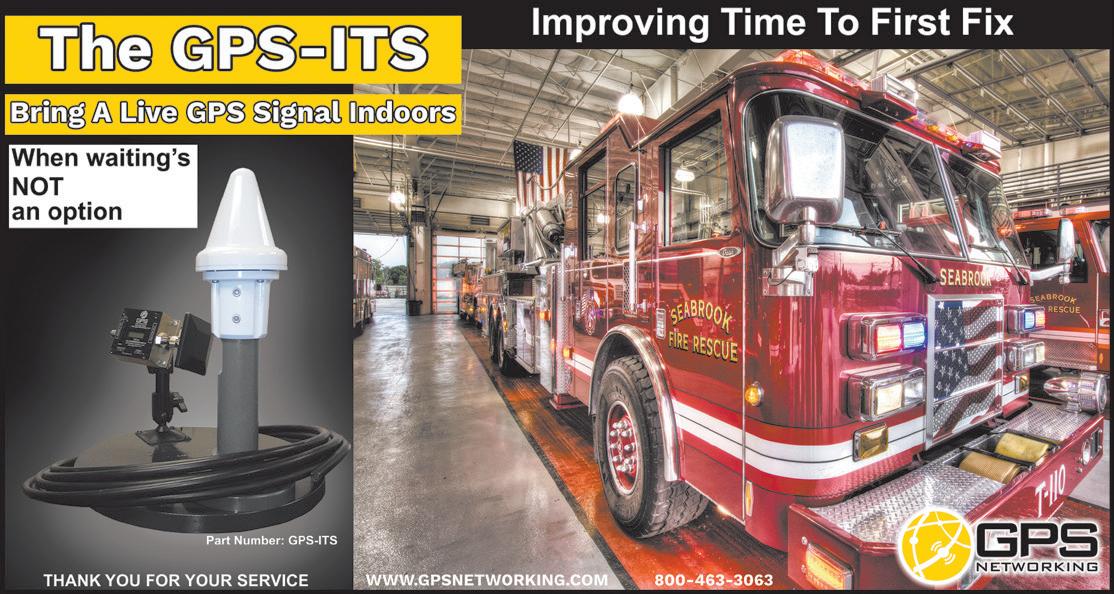
10 minute read
Thermal Imaging
Thermal Imaging In Living Color? The Colorful and Confusing Thermal Imaging Fire Service Color Palette World
Firefighters who use thermal imaging cameras (TIC) may have noticed that there are numerous color Andy Starnes palettes and color temperature associations with fire service thermal imaging cameras. But have we considered what these color palettes are specifically used for? And how much training has been invested in properly educating firefighters in regard to properly interpreting this information? As the above photo shows three popular color palettes of the exact same image. One image may appear hotter or cooler than the other, however that is not the case. In the world of thermography, there are numerous color palettes used by professional thermographers. Thermography is a technique for detecting and measuring variations in the heat emitted by various regions of the body and transforming them into visible signals that can be recorded photographically (Merriam Webster Definition).
Advertisement
Firefighters use qualitative

thermal imaging cameras. These are designed to detect heat and look for anomalies but not exact measurements. Fire service TICs are not thermometers and can vary in their accuracy based on the detector and the variables of the environment they are used in. The majority of these color palettes are designed for lower temperature environments that have limited contrast (or temperature differences) to assist in highlighting specific areas of interest. These color palettes were designed for specific industrial applications in lower contrast and lower temperature environments




IMAGE 1
NOT for the Fire environment. When these color palettes are used in high temperature environments, they can confuse firefighters and produce a very obscure image
These color palettes may include: • Rainbow or High Color (see Image 1) • Fusion or Iron Bow • Fire and Ice • Black Hot (or Inverse/Reverse
Polarity) • Green Hot • And many others.
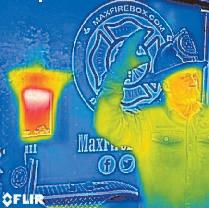
Many firefighters are familiar with NFPA 1801 (The Standard of Thermal Imagers for the Fire Service). However, NFPA 1801 did not completely standardize color palette usage and prevent confusing color temperature associations. However, NFPA 1801 (The Standard on Thermal Imagers for the Fire Service) set the approved color/ temperature progression for thermal imaging cameras known as the TI Basic Color Palette.
According to NFPA 1801 (Standard for Thermal Imagers for the Fire Service section 6.6.4.2.2 & 6.6.4.2.3) those colors should meet the following criteria: “Colorization shall overlay the grayscale thermal images produced by the thermal imager. Details within the thermal image and within the colorized area shall remain resolvable by the user other than at saturation.”
What Does This Mean to Firefighters?
Fire service TICs featuring the TI Basic Color Palette have a base palette of gray scale. When colorization was originally added to the first fire service TICs it would obscure or block out any details behind the color. Fire service TICs that follow NFPA 1801 produce a much clearer image than imagers in years past by providing higher resolution and colorization that allows details to be resolvable such as the adjacent images.
Whereas, a fire service TIC that does not follow the NFPA 1801 will obstruct details within the image when colorization is used such as in the photo (Image 2). Firefighters need to understand the power the value of greyscale and colorization. Without proper training in live fire environments, firefighters will fail to interpret the data correctly no matter the colors used by the manufacturer to represent the overall thermal environment.
Notice in the photo (Image 3), the firefighters are seated around the corner from a fire
Most firefighters are employed by a city or county government. As such, any workers’ compensation claim would be filed under the jurisdiction of the workers’ compensation law of the state in which they work.
room. Without proper training and understanding, a firefighter would be inclined to think they are in a low temperature environment. However, this is not the case. When assessing thermal severity, firefighters must consider all cues and not just the thermal indicators. In this particular case, this camera doesn’t switch to Low Sensitivity until three percent of the measured area is over 240 degrees Fahrenheit and has a Distance to Spot Ratio of 30:1. In this case, the spot temperature measurement is focused on the firefighters and not the superheated areas above their heads.
Notice the white areas (this is a sign of heat in this camera) and notice the subtle convection currents that could easily be missed if a firefighter scans too fast. In addition, this particular TIC doesn’t show colorization until 500 degrees Fahrenheit. Many fire service TIC instructors believe strictly in grey scale. Grey scale allows the most identifiable areas of contrast by the human eye. However, a color palette that has more than 50 percent grey scale has been an increasing issue with firefighters due to the following reasons.

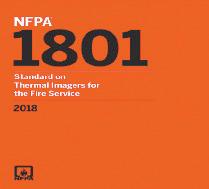
• Firefighters are not properly trained nor educated in TIC use. They associate color with danger and in many cases only read the spot temperature which is not indicative of the overall environment’s approximate temperature range. • Firefighters don’t respond to grey scale especially if they are not trained in their particular
TIC and its corresponding color/temperature correlations. • The human eye can
see THERMAL page 42
Thermal Cont’d from page 41 differentiate 30 shades of gray when not under stress but only four shades of grey when under stress. Therefore, having an area that is colorized is important to highlight areas of thermal severity. Firefighters work in fast paced, rapidly changing environments where a small thermal cue that is missed could be the difference between saving a victim or missing one. This is further exemplified in the fact that many fire service TICs use as many as 246 shades of grey in their base grey scale imagery. Whereas the human eye can only differentiate a few of those contrast changes. Early colorization provides greater situational awareness when in the hands of a properly trained firefighter by sounding the alarm with color that quickly stands out to the firefighter. Therefore, the following recommendations per NFPA 1801 provide a great start for thermal imaging manufacturers to heed:
NFPA 1801: Standard on Thermal Imagers for the Fire Service-chapter 6.6.4.1.9 states
In the TI BASIC mode, the heat color reference bar shall have a color scale that includes only the following colorization:
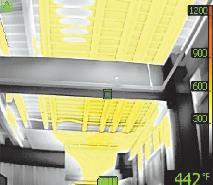

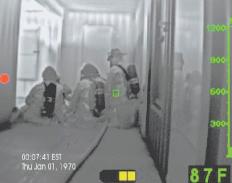
IMAGE 3
IMAGE 5
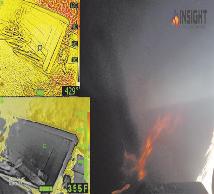

IMAGE 6
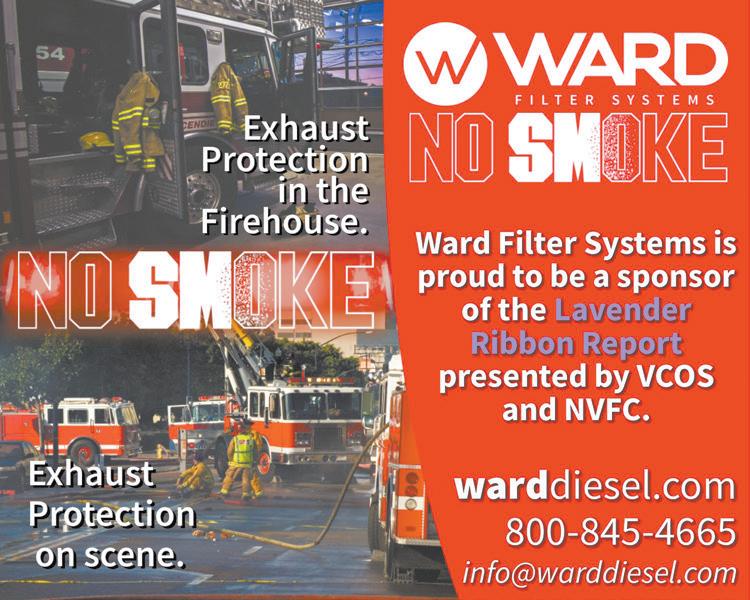
IMAGE 4

(1) Greyscale — at the bottom of the heat color reference bar before color indication begins and shall not be more than 50 percent of the overall height of the heat color reference bar. (2) Yellow — at the low end of the heat color reference bar (3) Orange — in the middle of
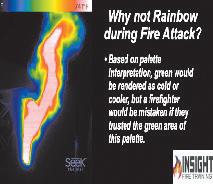

IMAGE 7
the heat color reference bar (4) Red — at the high end of the heat color reference bar
As shown in the (Photo 4) image.
In addition to this data, if the TIC is outside of its distance range (distance to spot ratio) it will not switch to low sensitivity or show colorization until it’s within the proper distance to the target. This is demonstrated in the photo (Image 5) taken during size-up where the TIC stays in High Sensitivity Mode. There is significant heat on the second floor but the TIC is far enough away and at an angle where it is not receiving enough infrared energy for it to switch to Low Sensitivity.
NFPA 1801 states in regard to colorization that:
“The colors yellow, orange, and red shall have a corresponding, temperature dependent change in hue as temperatures increase.” Notice that there is no uniform standard “corresponding, temperature dependent” for each color.
This can lead to confusion when
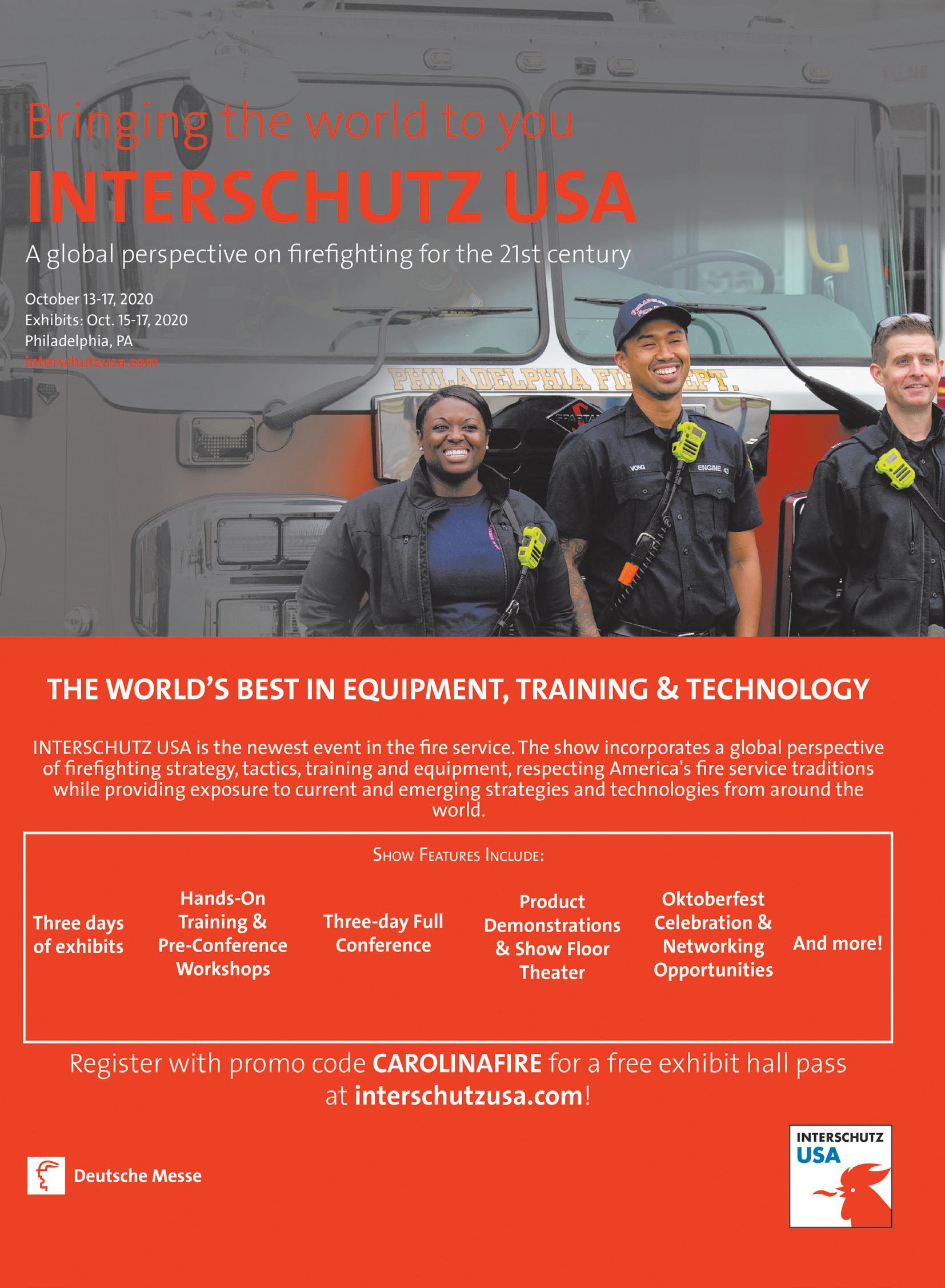
Thermal Cont’d from page 42 firefighters using TIC that fails to show color until 1000 degrees Fahrenheit when another brand shows colorization at 500 degrees? What happens when firefighters associate colors with specific dangers and fail to recognize the severity of the thermal threat in gray scale? As shown in the adjacent image comparing two high resolution fire service TICs; one shows the floor of the bedroom as a hostile environment whereas the floor in the lower image is shown in grey scale. Firefighters would be inclined to believe that the floor is cool when in fact it is extremely hot.
In many cases, fire service thermal imaging camera manufacturers choose which temperature they want colorization to appear — and in which sensitivity modes whether in high or low or both. This can be explained in the following comparison between the FLIR K65 versus the MSA Evolution 6000 color palette in Low Sensitivity (Image 6). A firefighter who fails to understand when colorization engages (outside of grey scale) and which sensitivity mode they are operating in can be injured or worse by misinterpreting the thermal data. Therefore, it is imperative that the firefighter know and understand their specific brand/model of TIC and its

benefits and limitations.
Which is More Important? Grey Scale or Colorization?
Thermal Imaging cameras that offer confusing non-fireground specific color palettes can


overwhelm firefighters with too much information who only have seconds to interpret the image and make a decision. To further exemplify this point, (see Image 7) with the Max Fire Box. Firefighters would be prone to think that blue and green would be cool but, in this case, it is cooler than the fire, but it is still very hot.
In researching many of the thermal imaging camera manufacturers, most of these fails to provide the associated temperatures with these colors. If this color palette is to be used, it would be useful for locating overheated components in a structure but not during fire attack. These color/ temperature associations are camera specific and must be learned by the firefighters to use the TIC to its maximum benefit.
In closing, thermal imaging manufacturers and NFPA need to standardize the color/temperature associations. If a requirement of NFPA 1801 is interoperability, a TIC that offers different color/ temperature associations compared to another NFPA 1801 TIC will only further confuse firefighters. And in many cases, it may lead to improper interpretation, injury, or worse. Firefighters have to make quick decisions based on incomplete information. Let’s not make a firefighter’s decision-making process more complicated. Simplify thermal severity and the interpretation by making a uniform color/temperature association that ALL fire service manufacturers SHALL abide by. Grey scale and colorization are both important and necessary in a balanced display in order to provide a contrasting image that firefighters can quickly identify areas of concern, thermal severity and victim locations. Fire departments interested in upgrading their thermal imaging cameras would be wise to learn the criteria based components of NFPA 1801 before making their purchase. Each fire service TIC provides advantages and disadvantages but the biggest detriment to thermal imaging use is the lack of education and training.
Andy Starnes has been involved with the fire service as a volunteer since 1992 and as a career firefighter since 1998. He serves on the CISM team, peer support team, and assists members within his own department in the area of behavioral health. Starnes currently serves as a Battalion Chief in a large career department in North Carolina and is the founder of Insight Training LLC , which is internationally recognized for thermal imaging training and education. He also serves as the Deputy Chief for KTF Burns Division, and holds a Level II Thermography Certification, consults and teaches in the areas of Tactical Thermal











